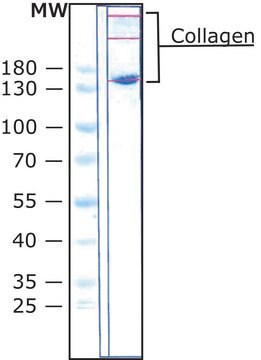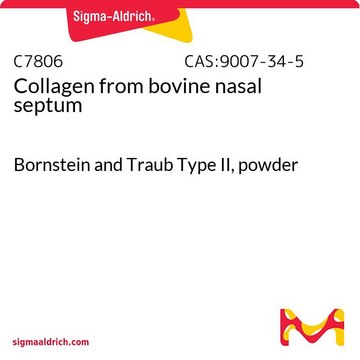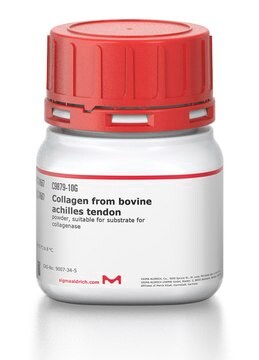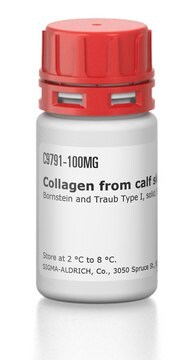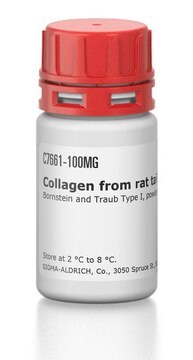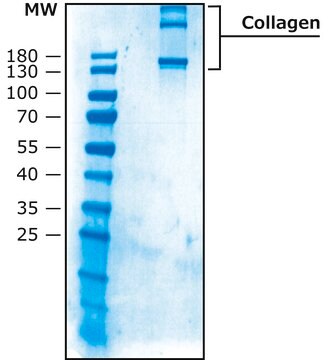C1188
Collagen from bovine tracheal cartilage
Bornstein and Traub Type II, powder
Zaloguj sięWyświetlanie cen organizacyjnych i kontraktowych
About This Item
Polecane produkty
pochodzenie biologiczne
bovine cartilage (tracheal)
Poziom jakości
Postać
powder
rozpuszczalność
aqueous acid: soluble
numer dostępu UniProt
temp. przechowywania
2-8°C
informacje o genach
cow ... COL2A1(407142)
Opis ogólny
Collagen protein is abundantly present in human. It is the prime structural constituent of dermis. It is also an important constituent of extracellular matrix (ECM).
Collagen is classified into a number of structurally and genetically distinct types. We use the nomenclature proposed by Bornstein and Traub. Do not confuse Sigma type designations with recognized collagen classification types.
Zastosowanie
Collagen from bovine tracheal cartilage has been used to induce arthritis in male DBA/1 mice. It has also been used as a fluorophore to acquire fluorescence emission spectra on the reflectance and fluorescence lifetime spectrometer (RFLS).
Collagen-type II has been investigated for its importance in haemostasis. Two peptides, CB8 and CB11, are sites of platelet binding and activation on collagen-type II. Collagen-type II has also been used as a model for arthritis in animals, where FR140423, a selective cyclooxygenase (COX)-2 inhibitor, has shown an anti-inflammatory effect without gastric lesions that may occur with treatment via indomethacin.
Collagen Type II is sometimes used to induce an animal model of rheumatoid arthritis. However, under conditions leading to formation of reactive oxygen species, the subjects develop tolerance for auto-antibodies. This is an unusual situation of ROS having a favorable effect.
Collagen Type II is sometimes used to induce an animal model of rheumatoid arthritis. However, under conditions leading to formation of reactive oxygen species, the subjects develop tolerance for auto-antibodies. This is an unusual situation of ROS having a favorable effect.
Działania biochem./fizjol.
Collagen participates in the aging process. It offers a structural framework for cells and mechanical strength to tissues.
Uwaga dotycząca przygotowania
Prepared by a modification of the pepsin extraction procedure of Trentham, et al., J. Exp. Med., 146, 857 (1977).
This page may contain text that has been machine translated.
Kod klasy składowania
11 - Combustible Solids
Klasa zagrożenia wodnego (WGK)
WGK 1
Temperatura zapłonu (°F)
Not applicable
Temperatura zapłonu (°C)
Not applicable
Środki ochrony indywidualnej
Eyeshields, Gloves, type N95 (US)
Certyfikaty analizy (CoA)
Poszukaj Certyfikaty analizy (CoA), wpisując numer partii/serii produktów. Numery serii i partii można znaleźć na etykiecie produktu po słowach „seria” lub „partia”.
Masz już ten produkt?
Dokumenty związane z niedawno zakupionymi produktami zostały zamieszczone w Bibliotece dokumentów.
Klienci oglądali również te produkty
Rosalia Cuahtecontzi Delint et al.
Biomaterials, 276, 120996-120996 (2021-07-20)
One of the major challenges within the emerging field of injectable stem cell therapies for articular cartilage (AC) repair is the retention of sufficient viable cell numbers at the site of injury. Even when delivered via intra-articular injection, the number
Aging and the skin
Brocklehurst's Textbook of Geriatric Medicine and Gerontology, 133-137 (2010)
Quantitative molecular sensing in biological tissues: an approach to non-invasive optical characterization
Chandra M, et al.
Optics Express, 14(13), 6157-6171 (2006)
Molecular and cellular basis of hypertrophic scarring
Total Burn Care, 495-505 (2012)
Important role of interleukin-3 in the early phase of collagen-induced arthritis
Bruhl H, et al.
Arthritis and Rheumatism, 60(5), 1352-1361 (2009)
Nasz zespół naukowców ma doświadczenie we wszystkich obszarach badań, w tym w naukach przyrodniczych, materiałoznawstwie, syntezie chemicznej, chromatografii, analityce i wielu innych dziedzinach.
Skontaktuj się z zespołem ds. pomocy technicznej